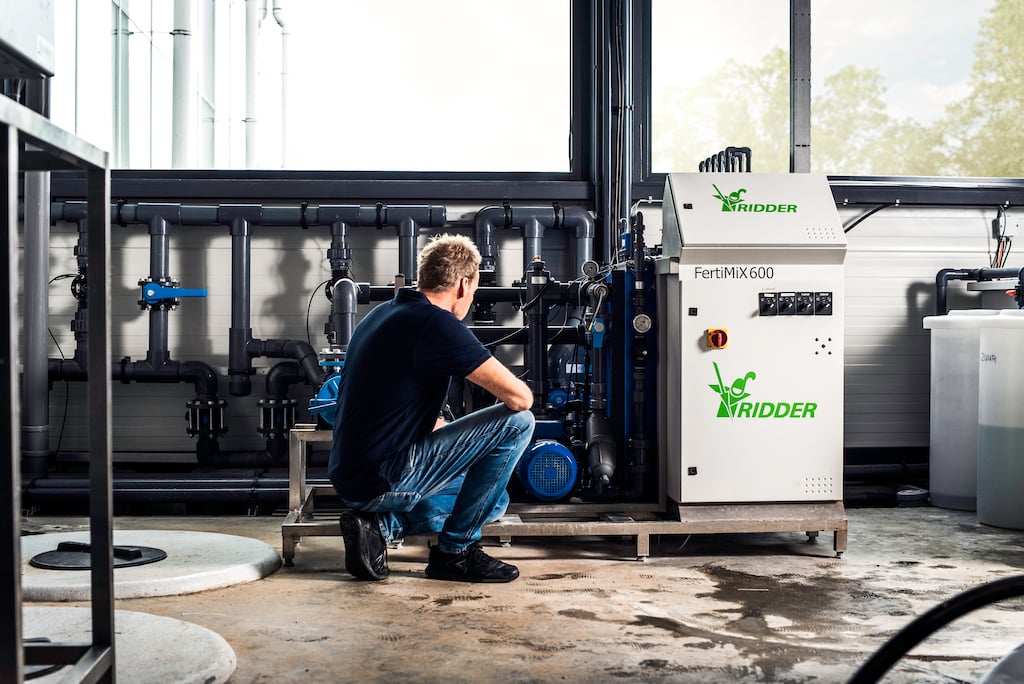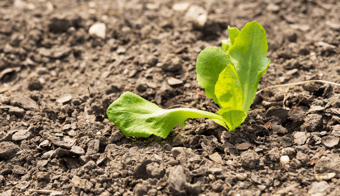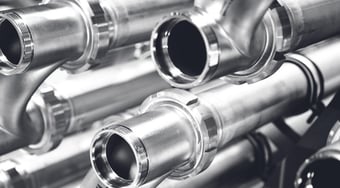Capacity and water pressure
It all starts with the purchase of your fertigation system. First, you should determine what capacity you need in your situation. How much water should go to the plants and how much pressure needs to be built up. If you have overhead irrigation, the water is pumped upwards, and you will need higher pressure than if you use a dripping system. When you use daily stock tanks, where water and fertilizers are stored, you’ll need a lower water pressure than when you use a dripping system.
Water is distributed throughout the greenhouse using irrigation valves. Each valve is linked to several crop rows and to a certain number of plants in the greenhouse. You’ll need to divide the valves into valve groups and then determine for each valve group in which period you want to apply which fertigation recipe. In practice, it sometimes happens that these valve groups are not the same size. As a result, one valve group may cover, 2,000 m2 of plants, while another group covers 4,000 m2. This means the water requirement for each group will differ, resulting in a pressure difference. When possible, it is best here to equalize the water requirement of the valve groups, so that the pressure will be the same everywhere. When purchasing a fertigation system, such as the Ridder FertiMiX, it’s important to keep this in mind.
Fertigation recipe
Once you’ve made the decision to work with a fertigation system in your greenhouse, you will need to set a fertigation recipe. This recipe specifies how your system should manage your water supply, the ratio between fresh water and disinfected drain water, how much water you want your plants to receive, which fertilizers should be used, and the acid dosing schedule. The recipe is sent to the different irrigation valves, which will then need to be divided into valve groups. This allows you to determine for each valve group in which period which recipe is to be applied.
Starting conditions
Modern fertigation systems also include other settings that you will need to configure. You can, for example, program when the system should rinse the filters and how it should manage your water storage tanks and basins. You’ll also need to define when a storage tank or basin is considered full or empty when to trigger an alarm that the water level has dropped too low, and at what level you want to use the tank with the disinfected drain water. But most important are the starting conditions. Traditionally, irrigation starts at fixed times
during the day. However, solar radiation (sunlight) can also affect when irrigation should start as it is linked to crop transpiration. On a cloudy day, when little radiation is measured, you will reach the target radiation sum later in the day. This means you will need to start irrigation later. Conversely, on a sunny day, you will start irrigation earlier. These are all common practices in horticulture.
Next level irrigation
A more advanced method of irrigation is to apply water based on the undersaturation level of the substrate slabs. This is one of the measurements provided by the Ridder ProDrain. The main advantage of measuring undersaturation is that you’ll know precisely what the crop's water needs are at any given time. What’s more, this measurement is available day and night. Solar radiation, for example, is only available during the day. In addition, by measuring undersaturation, you will know in advance what your drain water volume is going to be. This also tells you how much water you will need to add to achieve the desired drain water percentage. The measurements in the Ridder ProDrain can be used to adjust and optimize your irrigation scheduling. This next level of irrigation ensures that your plants will always receive the right amounts of water, at the right times. This could, for example, prevent tomatoes from bursting due to too much water application at the wrong time.
Scaling up
The use of an advanced system for irrigation and water management is especially beneficial for companies that want to scale up and are dealing with changing circumstances. If you run a large greenhouse operation, it is becoming increasingly difficult to do everything yourself and to rely solely on your growing instincts. Therefore, ideally, you will need a system that can take the guesswork out of your irrigation scheduling and automate some of the work, which is possible with the Ridder FertiMiX and ProDrain. Of course, another important reason to choose a more efficient and more precise way of irrigation is that you can achieve higher yields. After all, as the saying goes, to stand still is to go backwards.
Webinar: 'do's and dont's in water recirculation
Water recirculation in greenhouses is not just about saving water and valuable fertilizers. Recirculating water makes your greenhouse more efficient, sustainable, and future-proof. However, starting with water recirculation has its challenges. Watch out webinar-on demand for free here.




